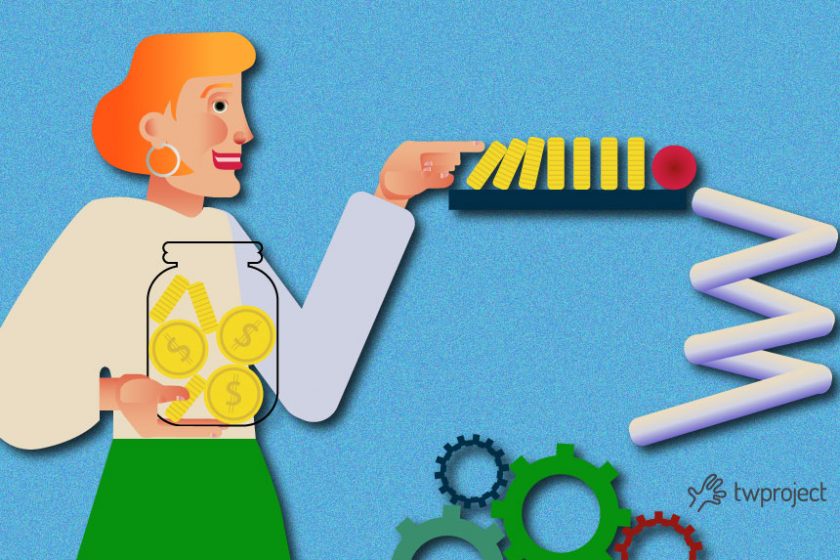Project benefits are referred to as “the measurable improvement deriving from a result perceived as an advantage by one or more stakeholders, which contributes to the achievement of one or more organizational objectives”.
CONTENTS
Basically it means that the benefits should represent an improvement resulting from the project.
The purpose of launching any project is, in fact, to provide some kind of benefit as a result of the delivery of the output.
It is obvious that not all projects bring the same benefits to the organization. Let’s look at some types of benefits that we can achieve.
Types of benefits in a project
The types of benefits are, as stated earlier, variable. Here are some concrete examples:
- Quality improvement,
- Production cost reduction,
- Error rate reduction,
- A higher level of customer service,
- Increased customer retention rate.
Benefits can be tangible or intangible.
A tangible benefit is quantitative, i.e. something that we can measure, such as a reduction in operating costs.
An intangible benefit is something that cannot be measured accurately, although its effects are visible, such as increasing brand awareness.
The performance management plan describes what the benefits of the project will be and how they will be classified and measured.
In order to measure the delivery of some benefits, such as cost reduction, a study of current costs within the organization is useful so that the project manager can compare it after the delivery of the project.
The benefit management plan will therefore include the following key elements:
- A description of the benefit that should be provided.
- The “owner” of the benefits.
- How to determine the benefit.
- Assumptions and risks considered in determining the benefit.
The resources involved must revise the plan throughout the project lifecycle to ensure that the stated benefits remain on the project’s delivery path.
Some benefits, in particular, may be awarded even after the project’s delivery, which is why monitoring and measuring benefits may expand beyond the completion of the project.
Benefit management process
The project benefit management process cpnsists of four distinct phases. In each phase there are a number of associated key objectives, activities and results. These are:
1. Definition of benefits
The project must clearly outline what benefits will be provided and how they will be quantified before the start of the project.
The audience for this communication consists of all stakeholders who share an interest in the project.
When defining the benefits, it is important to take into account that most of them occur after the distribution of the output.
Therefore, the measurement and communication of benefits should also – and above all – continue after implementation.
2. Structuring of benefits
It can be tricky to know when and how to assess the benefits of a project, but it is important to make sure to specify:
- What to measure and what to expect.
- What measures will be used and how these measures comply with the general measures of the organization.
- When and how to assess the benefits.
- What is the threshold of success for the realization of the benefits.
- What will be the impact on the project if the measured benefits do not match the expected benefits?
It is imperative that the method of measuring the benefits is established before the launch of the project.
3. Implementation and monitoring of project benefits
Once the project starts, it is also important to measure and report on the actual outcomes against the expected results throughout the entire life cycle and not just at the end of it.
These reports can be used during periodic reviews to assess whether a project is still on track in terms of benefits.
Often it may seem that a project is on track, but if there are no formal reports it may be impossible to know that for sure.
Regular reporting will clearly show whether a project can achieve its objectives.
Clearly, in many cases the final benefits cannot be determined during the project, however we can measure progress towards the benefits and then determine whether action is needed before it is too late.
Often the achievement of benefits can be influenced by factors external to the organization, such as government, competitors, and customers.
These factors must then be included in the measurement and taken into account to determine whether the project is still valid.
4. Assessment of benefits
Monitoring the benefit measures and comparing them with the expected benefits identified at the start of the project will provide a good indication of a project’s performance.
This performance evaluation can be a useful guide in determining what course of action should be taken in relation to the project.

It is a fact that projects do not always achieve the expected benefits and that there are several levels of success.
Having hard data and comparing it to a predetermined threshold will help the organization maximize the potential of a project and know when there is no benefit to it.
The benefit management process certainly offers a structured approach to managing the benefits of a project, but this does not mean that this is a mechanistic activity; it is proactive and takes into account changes.
7 reasons why projects fail to deliver benefits
Sometimes it can happen that a project cannot deliver benefits. How come?
The reasons are different, but mainly this is due to:
- The initial work on identifying strategic benefits has not been expanded or developed.
- Poor definition of the corporate objectives of the projects.
- No mechanism or strategy in place to manage the achievement of the benefits.
- Poor commitment from key stakeholders to delivering the benefits.
- Lack of unambiguous ownership of the benefits.
- Lack of robust processes to monitor benefits.
- No updating in case of changes during the project lifecycle.
That is why it is important to have a clear and structured benefit management process.
To be successful, this must become standard practice for the organization, especially every time a new project starts.
During the life cycle of a project it may be necessary to change objectives, change priorities or redefine desired outcomes in light of changing circumstances.
It is critical that this process continues throughout and beyond the life of the project to ensure that the benefits are achieved.
Making project benefits clear with Twproject
We have seen the unforeseen events that can lead to an unclear definition of objectives, and thus to their non-achievement. Furthermore, it may happen that benefits, even when achieved, are not shared with stakeholders.
This happens when we do not use a clear planning strategy from the beginning.
Who can help with this? Undoubtedly, the use of a management and planning software such as Twproject is a good solution.
Twproject guides you in building your projects step by step, helps you define budgets, objectives, key points. Thanks to its interactive Gantt chart you can realistically plan each phase of your projects, set milestones and prevent critical paths.
And in doing this, you can always keep your stakeholders up-to-date so that they always know when tangible as well as intangible goals have been reached.
Forget chaos and approximation and embrace a new philosophy of organisation and sharing. Try Twproject for free for 15 days and you will not regret it.





